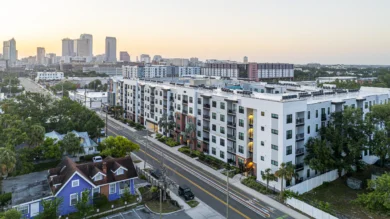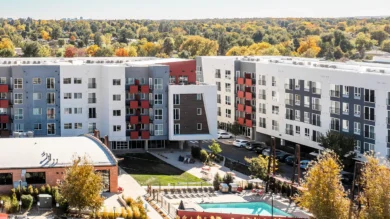
Executive Insights: Navigating the Changing World of Office, Industrial Real Estate
 Belvedere Place, Mill Valley, CA
Belvedere Place, Mill Valley, CA
Current market conditions pose ongoing challenges to all sectors of the commercial real estate industry and its investors, particularly those with positions in office assets and highly leveraged properties. With high borrowing costs, an anemic lending environment (for both new acquisitions and refinancings), and the lasting effects of the pandemic limiting demand for office space, commercial property investors are seeing significant reductions in both distributable cash flow and asset values.
In more severe cases, lenders are beginning to feel the effects of value impairment, and we are likely in the early innings of what could become a more significant commercial real estate debt crisis. However, there are segments of the industry showing continued strength and healthy leasing fundamentals, namely the light industrial sector. Furthermore, we believe generational opportunities in the commercial space will present themselves over the next 12 -24 months, particularly once foreclosures and bank-owned asset sales become more commonplace.
In this article, we will offer targeted insights to help navigate this evolving landscape and shed some light on Graham Street Realty’s strategy and decision-making in this demanding environment. Critical to this discussion is an understanding of what is happening in the capital markets and with leasing activity. We will dive into each, so you can have a better sense of where we are now and what lies ahead.
In Memory of Our Friend and Partner, Dave Messing: Before continuing with the market updates, we want to take a moment to honor the memory of our dear friend and leader of Graham Street Realty and Paramount Property Company, Dave Messing. Dave was a trusted executive, and his contributions will have lasting impact on the businesses he led.
Capital Markets
Borrowing costs have effectively doubled over the past two years, from 3.5% to 7.0% for performing assets, with 8.5-10% interest rates typical for office properties. These higher borrowing costs were primarily driven by increases in underlying treasury rates, but spreads have widened as well, albeit less significantly. The lending market is extremely selective and far fewer lenders remain active. Those that are lending have elevated income-derived lending hurdles, meaning assets need higher cash flows to support debt. While Fannie Mae and Freddie Mac buttress and provide liquidity in the multifamily market, there is no equivalent on the commercial side of the market. Life insurance companies have become the primary originators of new loans. However, many of these companies have moved to the sidelines in the latter half of 2023, having already hit allocation targets. We expect this trend to partially reverse course in Q1 2024 as new life company allocation targets are set, but increased lender scrutiny of sponsors, submarkets and property types will likely persist.
Now, let’s take a look at how capital markets are impacting office and industrial investments in particular.
Office – Variable (or “floating”) rate bank debt has historically been the lifeblood of the office sector, but today, it is virtually non-existent for new deals and refinancings. The rapid escalation in short-term interest rates made shortfalls in operating cash flow a much more common occurrence, especially among assets with significant occupancy declines. As a result, only banks with deep sponsor relationships and/or significant recourse requirements (and sometimes both) are willing to originate new loans. Lenders use a Debt Service Coverage Ratio (DSCR) to determine whether a property has enough excess net operating income to service the debt obligations. These testing standards are becoming increasingly rigorous and fewer would-be borrowers (or assets) can qualify.
Industrial – Single-tenant, net leased properties have seen the largest corrections, with values down approximately 30-40%. These assets typically have longer term leases and therefore no mark-to-market potential in the near term, resulting in values that are more rate-sensitive to leveraged buyers. The single-tenant nature also creates a more binary vacancy risk should the tenant not renew, with many lenders effectively refusing to lend on such assets unless they can cross collateralize across multiple properties.
On the flip side, multi-tenant light industrial assets with shorter weighted-average lease terms (or “WALT”) in place have seen less significant corrections to value, down approximately 10-20%. This is because landlords have consistently grown in-place rents as existing tenants roll to market, partially offsetting the negative impacts to value driven by higher borrowing costs and cap rates.
Instances of distress in the light industrial sector are rare due to healthy leasing fundamentals, more diversified tenant rosters and lower loan-to-value ratios when compared to other asset classes, specifically office and multifamily. Fixed rate debt is also far more common in the light industrial sector when compared to office. Properties with assumable debt and/or shorter WALTs remain the most liquid from an investment sale perspective.
Leasing
Office – Vacancy rates continue to increase in most office markets and indications are that they will continue to rise. It is not uncommon for tenants to renew leases in only half of their pre-pandemic footprint, as businesses grapple with getting workers back to the office following the pandemic. Shorter-term leases are becoming more prevalent, particularly on renewals, as landlords, tenants and lenders effectively ‘kick the can the down the road.’ Additionally, leasing concessions are expected to increase in the quarters ahead, including free rent, broker incentive fees and higher tenant improvement allowances.
It is worth noting that “close-in” suburban markets are faring better, while downtown/urban infill properties are struggling, in some cases due to public safety concerns exacerbated by vacant buildings. Select Central Business District (CBD) pockets, like the North Financial District and Jackson Square in San Francisco, have emerged as winners, as they were historically dominated by finance-related tenants, rather than tech users who have been slower to return to the office.
Industrial – Leasing fundaments in this sector remain historically tight, with vacancy rates below 5.0% in most major metropolitan statistical areas (MSAs). Infill submarkets dominated by small-bay light industrial inventory are posting even higher occupancy rates, with outsized vacancy largely coming from late-cycle, bulk distribution product delivered on a speculative basis. There has still been very little new small-bay product delivered to most MSAs. The mid-bay asset class, with tenant sizes typically in the 20-50k square foot range, also remain tight.
While vacancies remain low, rental rate growth has decelerated significantly, in some cases dropping from as high as 40% year-over-year increases to single-digit rent growth. Looking ahead, we expect inflationary to slightly higher than inflationary rent growth in the small to mid-bay sector.
GSR’s Market Strategy
While the current environment is challenging, we are paying close attention to economic indicators and exploring defensive strategies. We are also maintaining ongoing and frequent dialogue with the most active leasing brokers in the markets we cover – there will be anecdotal evidence of improved leasing fundamentals “heard on the street” long before less ingrained investors read of market recovery in business publications. We firmly believe that once leasing markets improve, capital markets will follow, but only in that order. Our highly experienced team is in tune with both leasing and capital markets and making important strategic portfolio decisions for the benefit of our investors.
In employing our acquisition strategy we will continue to focus on infill small and mid-bay light industrial properties in key western U.S. markets. These multi-tenant holdings serve a wide and diverse spectrum of industries, including countless small businesses and many tenants of either regional or national credit, nearly all of whom do not have the option to work from home – inventory and equipment must be stored in warehouse space.
With respect to the office sector, we will focus on select micro-markets that offer diverse amenity bases and public safety. Of equal importance, we will pursue class-leading office and R&D assets that have superior physical traits (i.e., unobstructed views, heavy power) as a flight to quality paradigm persists amongst active tenants. In addition, we anticipate putting forth an outsized effort to purchase distressed office assets at steep discounts, especially as foreclosure and deed-in-lieu transaction volume increases.
In closing, we believe there are still opportunities to be found with the right strategy and industry foresight in place. Our goal, as always, is to create value for our investors through the inevitable ups and downs of the market. We are here for the long-haul and always just a phone call away.






